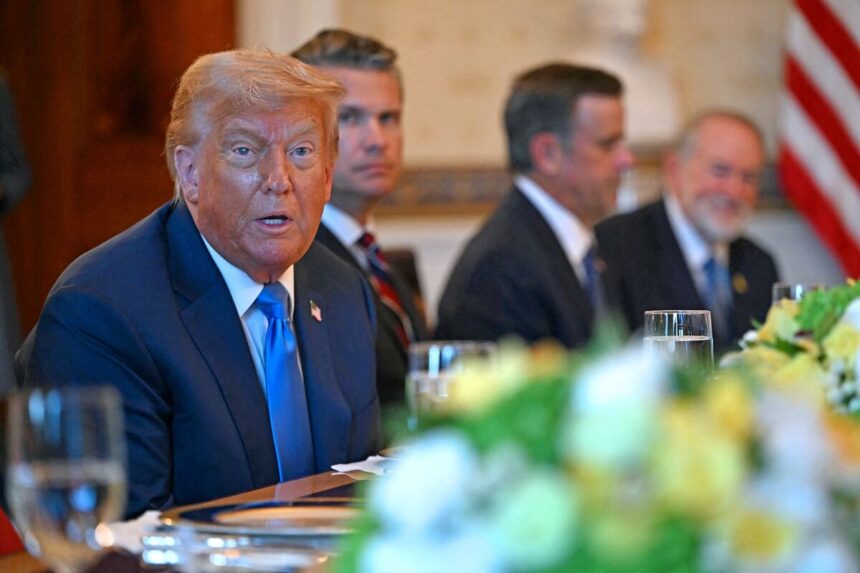As tensions escalate between Washington and major trading partners, President Trump has reinforced his position on the looming August 1st tariff deadline, declaring unequivocally that no extensions will be granted. “We’ve been too soft for too long,” Trump stated yesterday during an impromptu press briefing at his Mar-a-Lago estate. “August 1st is firm. After that, they’ll pay.”
Standing beneath the Florida sun in his characteristic navy suit, Trump appeared reinvigorated by the confrontation, especially as markets showed surprising resilience to the news. The Dow Jones slipped just 1.2% following his announcement, suggesting investors had already priced in the likelihood of new trade barriers.
This latest economic brinkmanship represents more than just routine negotiating tactics. According to State Department sources speaking on condition of anonymity, the administration has circulated internal memos preparing diplomatic missions for “prolonged economic realignment” with traditional allies, particularly in Europe and East Asia.
“What we’re seeing is essentially a replication of the first Trump administration’s approach, but with less internal resistance,” explains Mariana Hernandez, senior trade analyst at the Peterson Institute for International Economics. “The institutional guardrails that moderated some of his more disruptive impulses in 2017-2021 have been significantly weakened.”
The proposed tariff package—25% on all EU imports, 30% on Chinese goods, and varying rates for other nations—would represent the most comprehensive restructuring of America’s trade relationships since World War II. The Treasury Department estimates the measures could generate approximately $70 billion in annual revenue, though economists debate whether those gains would offset broader economic impacts.
During my visit to the Port of Long Beach last week, the effects of anticipatory market adjustments were already visible. Container ships from Asia were arriving in unprecedented numbers, rushing to beat the deadline. “We’re operating at 140% capacity,” said Miguel Ortiz, a longshoreman I interviewed as he supervised the unloading of a massive vessel from Guangzhou. “Companies are stockpiling everything they can before these tariffs hit.”
The European response has been particularly sharp. EU Trade Commissioner Paolo Gentiloni warned of “immediate and proportionate countermeasures” during yesterday’s press conference in Brussels. “We will not negotiate with a gun to our head,” he stated, flanked by representatives from Germany and France.
Behind closed doors, however, European officials appear divided. According to diplomatic cables obtained through sources at the EU Commission, several Eastern European nations have signaled willingness to negotiate bilateral agreements with Washington outside the EU framework—potentially undermining the bloc’s unified response.
The economic stakes extend beyond immediate price impacts. The Federal Reserve’s latest economic projections suggest the tariffs could add 0.8 percentage points to inflation in 2026, potentially forcing a reversal of recent interest rate cuts. For American consumers already struggling with elevated prices, the timing couldn’t be worse.
In Michigan’s manufacturing corridor, reactions split along predictable lines. “Finally someone’s standing up for American workers,” said James Kowalski, a former auto worker I spoke with at a diner in Flint. “These foreign countries have been eating our lunch for decades.” But across town, at a parts supplier dependent on global supply chains, CEO Melissa Richardson offered a darker assessment: “This could force us to lay off 30% of our workforce by year’s end.”
China’s approach appears more calculated than in previous trade disputes. Rather than immediate retaliation, Beijing has focused on strengthening alternative trade relationships, particularly through its Belt and Road network. “They’re playing the long game,” notes Dr. Wei Zhang of Georgetown’s School of Foreign Service. “Instead of tit-for-tat measures, they’re accelerating the creation of parallel economic structures that reduce dependence on American markets.”
The Treasury Department’s internal analysis, portions of which were shared with me by a senior official, projects first-year GDP impact ranging from -0.3% to -0.7%, depending on retaliatory measures. However, the same report suggests potential long-term manufacturing employment gains in specific sectors, particularly steel, aluminum, and certain technology segments.
For everyday Americans, the effects will vary dramatically by region and economic status. Import-dependent coastal states face consumer price increases potentially reaching 3-5% on affected goods, while manufacturing regions in the Midwest could see modest employment gains, according to analysis from the Economic Policy Institute.
What remains unclear is whether this hard deadline represents a genuine endpoint or simply another negotiating tactic. Trump’s previous administration frequently announced inflexible positions before later accepting compromises, particularly with China during the Phase One trade deal negotiations in 2019.
As August 1st approaches, one thing is certain: the global economic order faces its most significant restructuring test in a generation, with America’s traditional leadership role transforming from architect of openness to enforcer of restrictions. Whether this represents decline or renewal depends entirely on where you stand—and what you produce—in our increasingly fragmented global economy.






